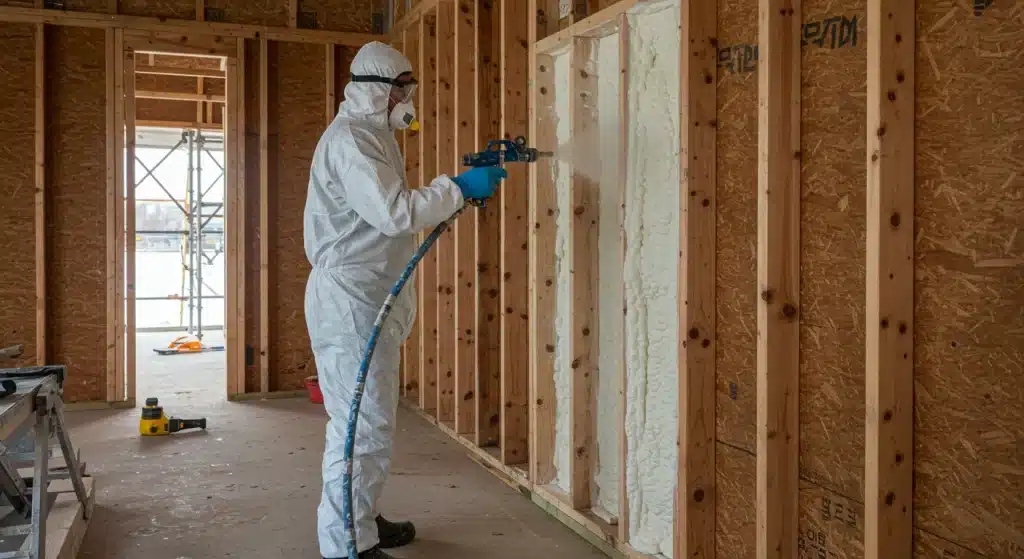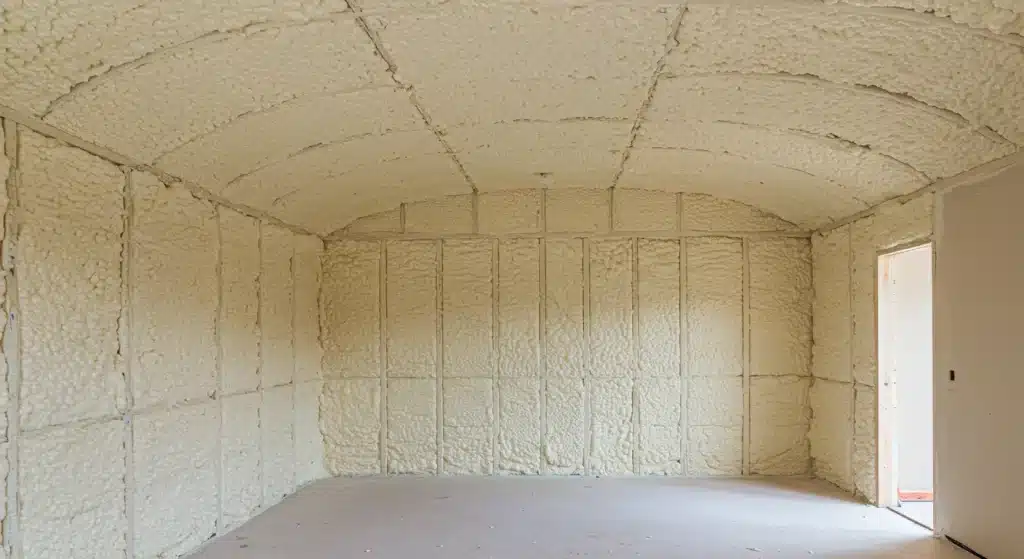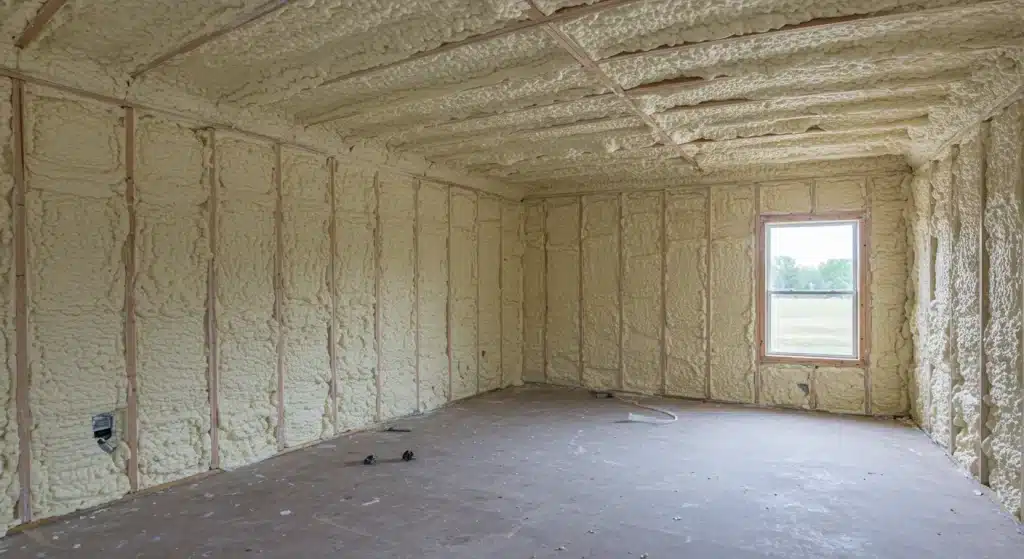Spray foam insulation directly improves daily home life by creating a complete air and thermal barrier. This single application addresses many common household frustrations, leading to more stable indoor temperatures, a quieter environment, and cleaner air. It works by expanding to fill every gap and crack, stopping air leakage in a way that traditional insulation materials cannot. The result is a more comfortable, energy-efficient, and healthier living space.
This guide explains the specific ways spray foam contributes to home comfort, drawing from extensive field experience in residential and commercial insulation projects. Understanding these benefits can help you identify solutions to persistent issues like drafty rooms, high energy bills, and poor air quality.
1. Unmatched Temperature Regulation
Consistent indoor temperature is the foundation of home comfort. Spray foam insulation excels at this by creating an almost impenetrable air seal. Air leakage is a primary cause of energy loss in homes. In fact, analysis from the U.S. Department of Energy suggests that uncontrolled air leaks can account for a significant portion of heating and cooling costs. By stopping this air exchange, spray foam prevents outdoor heat from entering in the summer and keeps heated air inside during the winter. This eliminates the hot and cold spots that often make certain rooms uncomfortable.
Bonus Tip: For the best results, ensure that windows and doors are also properly sealed. Even the best insulation can be undermined by a drafty door frame. Addressing these small air leaks complements the whole-home seal provided by spray foam.
2. Superior Sound Dampening
A quiet home is a peaceful home. Spray foam insulation helps reduce the transmission of both airborne and flanking noise. Open-cell spray foam, in particular, has excellent sound-absorbing properties. Its soft, flexible cell structure is effective at muffling noises from outside, like traffic or neighbors. It also dampens interior sounds, such as plumbing running through walls or footsteps from an upper floor. This creates a quieter environment, which is especially beneficial for home offices, bedrooms, and media rooms.
Insulation Sound Dampening Comparison
| Insulation Type | Typical STC Rating* | Primary Sound Control Mechanism |
|---|---|---|
| Fiberglass Batts | 35 – 39 | Absorption |
| Cellulose (Blown-in) | 40 – 44 | Absorption & Mass |
| Open-Cell Spray Foam | 37 – 39 | Absorption & Sealing |
| Closed-Cell Spray Foam | 36 – 38 | Mass & Sealing |
*STC (Sound Transmission Class) ratings can vary based on the complete wall assembly and installation quality.
3. Improved Indoor Air Quality
The air inside a home can often be more polluted than the air outside. An effective air barrier helps control what comes into your living space. By sealing cracks and crevices in the building envelope, spray foam significantly reduces the amount of dust, pollen, and other outdoor allergens that can enter the home. This is a major benefit for individuals with allergies or respiratory conditions. A U.S. Environmental Protection Agency guide on home environments explains that controlling moisture and air infiltration is key to maintaining healthy indoor air. A well-sealed home gives you more control over your indoor environment.
4. Effective Moisture and Mold Control
Moisture intrusion is a serious threat to a home’s structure and the health of its occupants. Closed-cell spray foam acts as a vapor barrier, resisting the movement of moisture through the wall cavity. This prevents condensation from forming inside walls, which is a common cause of mold and mildew growth. By keeping building materials dry, closed-cell foam protects against rot and decay, preserving the structural integrity of the home while preventing the musty odors associated with dampness.
5. Enhanced Structural Integrity
Beyond its insulating properties, closed-cell spray foam adds structural strength to a building. When applied, it adheres tightly to the surfaces and becomes rigid upon curing. This essentially glues the wall studs and sheathing together, creating a stronger, more durable wall assembly. In fact, technical documents from the Spray Polyurethane Foam Alliance confirm that closed-cell foam can significantly increase a wall’s resistance to racking forces from high winds. While not a substitute for structural bracing, this effect contributes to the overall resilience of the home.
6. Pest Deterrence
Pests often enter homes through the same small cracks that allow air leakage. Spray foam seals these entry points. Once cured, its hard, dense structure also presents a significant barrier to insects and rodents. Unlike fiberglass or cellulose, which can be easily chewed through or nested in, spray foam offers no food value and is difficult for pests to penetrate. This helps keep unwanted critters out of your walls and attic.
Bonus Tip: Pay special attention to insulating and sealing the rim joists in a basement or crawl space. This is a common entry point for pests and a major source of energy loss.
7. Consistent Long-Term Performance
Some insulation materials can settle, sag, or compress over time, creating gaps that reduce their effectiveness. Spray foam is a permanent solution. It adheres to the structure and does not lose its shape or R-value over the life of the building. This means the comfort and energy savings you experience after installation will continue year after year without needing maintenance or replacement.
Things to Consider Before Choosing Spray Foam
While the benefits are clear, making an informed decision involves looking at several factors:
- Project Type: Is this for a new construction project or an existing home? Retrofitting can be more complex than installing insulation in an open wall cavity.
- Foam Type: Open-cell foam is excellent for sound dampening and is vapor-permeable, while closed-cell foam provides structural strength and acts as a vapor barrier. The right choice depends on the application area (roof, walls, crawl space) and climate.
- Ventilation Needs: Because spray foam creates a very tight home, you must ensure your home has adequate mechanical ventilation. A properly sized HVAC system or an energy recovery ventilator (ERV) may be necessary to maintain fresh air circulation.
- Professional Installation: The performance of spray foam is highly dependent on the quality of the installation. It requires trained technicians with specialized equipment to ensure it is mixed and applied correctly.

Frequently Asked Questions
Is there an odor after installation?
A professional installation includes proper ventilation during and after application. While there may be a slight odor during the curing process, it should dissipate completely within 24-48 hours, leaving the home with neutral air.
How long does the installation process take?
Most residential projects, such as an attic or crawl space, can be completed in one to two days. A full home insulation project may take longer, but the process is generally efficient.
Can spray foam be installed in an existing home?
Yes, it can be installed in existing homes. Technicians can inject slow-rise foam into enclosed wall cavities or apply it to open surfaces like attic floors and crawl space walls.
What is R-value and why does it matter?
R-value measures an insulation material’s resistance to heat flow. A higher R-value means better insulating performance. Spray foam offers some of the highest R-values per inch available, but its primary comfort benefit comes from combining a high R-value with a near-perfect air seal.
Can spray foam help with ice dams in the winter?
Yes. Ice dams form when heat escaping from the living space melts snow on the roof. The water then refrizes at the colder eaves. By properly insulating and air-sealing the attic floor or roof deck, spray foam prevents this heat loss, keeping the roof surface cold and stopping ice dams from forming.
How does spray foam affect a home’s HVAC system?
By creating a tight building envelope, spray foam reduces the heating and cooling load on the HVAC system. This often means the system runs less frequently and may even allow for smaller, more efficient equipment to be installed in new homes. The system can maintain the desired temperature more easily without constant cycling.
Is spray foam environmentally friendly?
Modern spray foams have evolved significantly. Many formulas now use blowing agents with low Global Warming Potential (GWP). Additionally, the energy savings that spray foam provides over the lifetime of a home can drastically reduce its carbon footprint, making it a choice that contributes to long-term environmental sustainability.
Is Spray Foam Right for Your Home?
The seven benefits outlined here show how a single insulation upgrade can have a widespread effect on your daily comfort. From stable temperatures and quiet rooms to cleaner air, the advantages are tangible. Evaluating your home’s specific issues, like drafty areas or high utility bills, is the best way to determine if this solution fits your long-term goals.
If you’re exploring options to make your home more comfortable and efficient, a professional consultation can provide clarity. The team at Supreme Spray Foam Fresno can assess your property and explain how different insulation strategies could work for you. For a detailed discussion about your specific needs, contact an expert at (559) 545-0800 or send an email to [email protected]. Getting accurate information is the first step toward creating a better home environment.
Click here to check out our helpful guidance for property owners to better understand how insulation performs throughout the year.
Sources
- U.S. Department of Energy – Provides official data and consumer advice on the impact of air sealing on home energy efficiency.
- U.S. Environmental Protection Agency – Offers comprehensive guidance on controlling moisture and mold to maintain healthy indoor air quality.
- Spray Polyurethane Foam Alliance – An industry technical document detailing how spray foam improves wall shear racking strength against wind and other forces.





